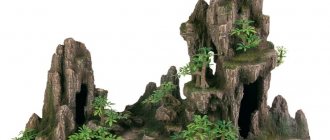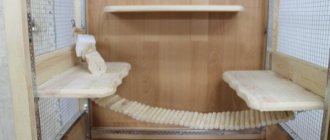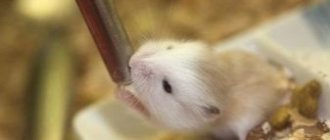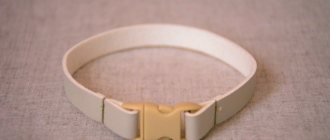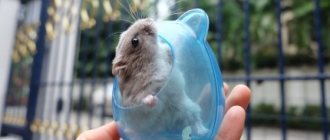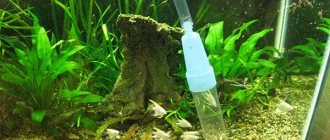Artificial lighting of an aquarium or terrarium is a mandatory attribute for the full growth and development of your plants, fish or reptiles locked in home glass jars.
The most convenient way to make this lighting is built into the lid of the aquarium, and this can be done in several ways, both under ordinary light bulbs with an E27 base, and under fluorescent tubes or LED strip.
However, before you start lighting, you need to make this very cover out of something. Let's look at three options for aquarium covers, and you can choose the most suitable one for yourself.
The first option is the simplest and most common among aquarists and involves the use of PVC panels, or the so-called lining, as a frame.
We will assemble the second cover based on sheets of foamed PVC. With their help, you can make a high-quality lid for both large and small volumes.
Well, the third, open type for herbalists on polypropylene pipes.
Cover frame made of PVC panel
PVC panels are the most popular material and there are several reasons for this:
- sufficient structural rigidity
- budget
- the material is easy to process and cut with a regular stationery knife
And the panel inside is hollow, which reduces the total weight that will be on top of the aquarium.
The size of the lid directly depends on the volume of the aquarium. If the dimensions and width are large, it will have to be made of three components - the front wall, the middle, the back wall. Well, plus the sides.
All this fits together easily and is assembled with glue like a construction set. Let's take a closer look at the manufacturing process of the option for large-volume containers.
To ensure better frame rigidity, it is recommended to use a double panel (simply glue one on top of the other).
In order for the lid to fit on the glass, a U-shaped groove must be cut along the edges of the PVC panel. With this groove, the front and back sides will seem to fit onto the walls of the aquarium.
Next we need to decide on the height of our cover. Do not forget that it will have a built-in backlight, which for some reptiles (turtles) must be located strictly at a certain distance from the water or island.
The bend should be at the marked height. To make it without damaging the outer layer of PVC, cut a strip of at least 1 cm wide on the inside of the front side with a stationery knife. No need to cut through!
Next, bend the lid at this point at an angle of 90 degrees and temporarily fix it in this position with masking tape.
Check the right angle with a square.
To give the lid a permanent shape, glue small plastic corners in the middle of the fold. They are made from rigid PVC plastic (this is not the same hollow panel!).
To do this, the plastic is pressed in the middle with a screwdriver, heated with a hot air gun and carefully bent at a right angle.
You can also buy factory plastic corners. They are sold in the same construction stores.
Glue the corners with superglue in several places on the bent lid.
Then apply silicone glue or cosmofen liberally to the previously cut fold.
It reliably seals any joints and slots.
It protects against the formation of mold or mildew in these areas.
We proceed to attaching the middle (straight) part of the lid. Cut it to the desired width and glue it to the previously bent piece.
To do this, wide grooves must be cut in the plastic along the edges of the two halves. Lubricate them with glue and place the halves together.
As a result, you should end up with one single design. While the glue dries, secure the workpieces with tape.
All that remains is to build the back wall. It is done similarly to the front one.
- U-shaped groove along the edge for installation in aquarium glass
- bend at an angle of 90 degrees according to the height of the lid
- inserting the central part
To more securely fix the middle half of the lid and create stiffening ribs, glue rectangular PVC inserts on the inside.
DIY aquarium lid: instructions
Having familiarized yourself with the possible materials for making an aquarium shelter, it is easy to notice that the simplest and relatively inexpensive option would be a PVC panel. Let's look at the step-by-step process of creating a roof for a tank using it.
What you will need
The list of necessary tools and materials includes the following:
- PVC sheet, at least 1 cm thick (can be bought at any hardware store);
- edging (thin plastic strip);
- a stationery knife or jigsaw for cutting lining;
- ruler, 1 m long;
- transparent glue;
- pencil;
- self-adhesive film (selected based on the personal preferences of the aquarist);
- foil;
- scissors;
- tape (necessary for temporarily fastening panels during operation).
Did you know? The first more or less modern aquariums appeared in England in the 19th century, and they owe their name to the English naturalist Philip Henry Gosse.
Step-by-step instruction
If you have all the necessary tools and materials, the process of creating an aquarium lid is a matter of technique. It cannot be called too difficult a task, especially if you follow some basic steps:
- Measuring the dimensions of the aquarium, taking into account the parameters of the side edges that rise above the aquarium (usually a height of about 7 cm is sufficient, the length of the front and rear edges is cut along the length of the walls of the tank, and the side edges - with a margin for fastening to the front and rear panels).
- Transferring all calculations to PVC sheets and cutting out blanks using a stationery knife or jigsaw.
- Assembling the structure, starting with connecting the frame parts (can be wooden), and attaching the support strips to fix the lining sheets.
- Fastening the sheets (for a rectangular aquarium, you may only need two of them, and one of them is made removable, and the second is securely fixed with glue to the support strips).
- Pasting the product with self-adhesive film.
- Attaching the handle to the removable part (facilitates the task of using the finished lid).
Some of the nuances of creation may be individual, but in general this is exactly what the process looks like.
Video: how to make a lid for an aquarium with your own hands
How to cover the lid
To give a homemade aquarium lid a finished look, all that remains is to cover it with self-adhesive film. Today there are many types of similar products, and in your work you can use both single-layer and multi-layer materials with different surface types and colors. With such a film, the aquarium roof will easily fit into any interior.
The following plants are used for the aquarium: hornwort, Java moss, cryptocoryne, Hemianthus micranthemoides and Anubias nanu.
End caps
It remains to close two ends. To do this, check their width on each side of the aquarium.
Please note that sometimes these sizes may differ by a couple of millimeters. Therefore, you need to measure on both sides, and not make them the same initially.
Measure rectangular blanks on PVC plastic and cut them to these dimensions. Next, use a knife to cut off all the partitions made of PVC plastic along the edges. Something like this.
The side walls should seem to fit into the lid itself and only then stick to it.
For rigidity, we again use plastic corners.
We seal all joints with glue and sealant. The finished lid design will look like this from the inside and outside.
To create a more attractive look, paint it in dark colors.
Or cover it with dark decorative film. It will look completely different.
It is better to apply the paint in several layers, otherwise the PVC panel may show through when the lights are turned on.
Cover for an aquarium made of PVC panels (plastic)
This material is very popular due to its strength and lightness. It cuts easily and sticks well. It can be decorated, painted, etc. But the most important thing is that he is not afraid of water. The manufacturing process itself is as follows:
1. Cut the plastic according to the measurements and drawing. This is done using a stationery knife;
2. Next, in the resulting pieces we immediately make holes for wires and tubes. To do this, you can use the same knife or another suitable tool;
3. Putting the details together. First, the side walls are glued together, and then the top panel. For this, you can additionally use plastic corners. Special glue (liquid plastic) is best suited for this. However, it is worth considering that it is quite toxic, and therefore this procedure must be carried out in a ventilated area;
4. We attach vertical stiffeners to the side walls from the inside. The upper edge will rest against the lid itself, the lower edge against the glass;
5. A hole is cut for feeding feed (any shape).
Many people are interested in an illuminated aquarium cover. In fact, the aquarist is faced with one task, namely gluing in fluorescent lamps.
To do this, two plastic strips (slightly smaller in width than the walls) are glued on the inside of the lid, along the entire length. A lamp is inserted into the resulting groove, which can be fixed with the same glue. All wires are laid in a special channel.
However, today aquarists are increasingly turning to LED lamps. Their only peculiarity is that they are not mounted into the lid itself. LEDs together with substrates are soldered onto an aluminum profile and connected to a wire. But you need to think through the design of such a lamp so that it can last even if the aquarium is without a lid. That is, it is installed on a stiffening rib, clings to the walls, etc. In this case, the design itself is only necessary to cover the lighting fixture.
How to get rid of condensation?
Many aquarists recommend gluing the inside of the lid not just with foil, but with a special thermal insulation material with a reflective coating.
Similar material is glued behind the radiator or placed under heated floors.
What does it give? First, the reflection of light.
But most importantly, this backing protects against heavy condensation on the inner surface of the lid.
It acts as an insulator against temperature changes, so that in any season of operation of the aquarium (spring or autumn), moisture will not accumulate on the surface of the lid.
Otherwise, situations often arise when the heating has not yet been turned on, the water in the aquarium is warm, but the room is cool. Hello, condensation and failure of electrics or light bulbs.
How to make a lid for an aquarium
Before you make an aquarium lid with your own hands, it’s worth figuring out what the end result will look like. You need to find out the dimensions of the sides of the container and the necessary elements. It’s also better to make a drawing: it will be much easier to work.
Example drawing for a cover
It is important to think about cleaning the tank: depending on the location of the parts, cleaning it later may be inconvenient. The material must be waterproof, resistant to elevated temperatures, safe and environmentally friendly. Experience shows that foamed PVC is the best option.
Before assembling the structure, all parts must be degreased to avoid problems in the future.
The side walls and the top are created separately and then assembled. They are glued together with glue - not just any glue is suitable for PVC, but in this case you can use “liquid nails” - that’s what construction glue is called. Immediately before gluing, it is better to take measurements of all the parts again and check if they match in size. If everything is correct, you can proceed to connecting the parts. It is very important to ventilate the work area when gluing so as not to be poisoned by glue fumes.
After gluing the walls, a corner is glued to each inner corner of the workpiece. Stiffening ribs are also installed on the inner sides of the side walls - elements designed to increase the rigidity of the structure. They are placed vertically, with the top close to the top, and the bottom close to the aquarium itself. Then carefully fill the glued areas with sealant. They make all the necessary holes: for wires, hoses, maybe for pouring out food.
Now that all the main work has been done, all that remains is to give the resulting item an aesthetic appearance. To do this, the structure is covered with self-adhesive paper or painted. However, painting a material such as PVC is a complex process. It is necessary to prime the surface or use special paints.
Filter in the lid
You can make a design with a filter that needs to be installed in the aquarium. To do this, in addition to the holes for the wires, you need to make several holes in the case for fastenings. The filter should be located in a corner near the rear wall as far as possible from the hatch. If the need arises, a platform can be made for the device.
Backlight
One of the important parts of the work is creating the backlight. The number of lighting lamps depends on the volume of the tank. Their wires must be properly connected, insulated and placed in metal holders located at the desired height. For cartridges, a piece of plastic is attached to the inside of the structure. Be sure to take into account all measurements, and then the lighting fixtures will not touch the water. And by using the inner surface of the lid, you can increase the amount of light. If you cover it with foil, the reflected light from the lamps will delight the fish.
Installation and connection of lighting lamps
Let's move on to lighting installation. First we will do it using ordinary LED light bulbs.
To turn the backlight on and off, you will need two switches. Don’t take bulky indoor two-keyboards; small “buttons” look much more beautiful.
The current in the circuit will be insignificant, so they will withstand such a small load.
The bulbs should be placed evenly over the area - some along the edges of the lid, the rest in the center. The outer ones will be turned on from one button, the central ones from the other.
Ceramic sockets will be needed for each light bulb. How to attach them to the lid? The best option here is clips for plastic pipes. For E27 cartridges they will fit 32mm.
The clip itself also needs to be screwed to the inner wall of the lid. If you used a single PVC panel rather than a double panel, you will have to make square platforms. Otherwise, the screw will pierce the wall.
Cut out square blanks from the same PVC plastic as the lid, and glue them to the inside, where the light bulbs will be.
Next, screw the clips into these places using small screws.
Insert a ShVVP wire 2*0.5 into each cartridge. Read how to properly connect a light bulb socket in a separate article.
The outer sockets are connected with one wire, the central ones with another. To ensure that the conductors remain intact when connecting several light bulbs, do not cut their copper strands, but simply remove the outer insulation and place a ring under the screw.
This parallel connection of several light bulbs in a row is widely used in the manufacture of makeup mirrors.
Cartridges with charged wires are inserted into the clip holder and stay there perfectly.
When connecting wires to the switch, do not forget that it is the phase conductors that must break through it. Zero goes directly to the paws, without the participation of a switch.
Small holes are cut out for the microswitches in a convenient place on the cover, where they are glued.
By connecting all ends, check the functionality of the backlight. To prevent the wires from hanging or dangling, glue them to the outside of the cover.
They can also be hidden in a separate box or cable channel.
Place the lid on the top of the aquarium and turn on the light. Don't forget to cut holes in the plastic for cables and hoses.
Making backlight
To prevent the aquarium lid from creating a shadow, you will need LED or energy-saving lamps with all the components. The wiring is connected, insulated, and the lamps are fixed in special holders that are adjusted to a certain height. Plastic cartridge supports are attached to the base of the lid. To ensure that electrical appliances do not touch water, measurements must be taken accurately.
Lack of light causes illness in pets and additional troubles. Special lamps for aquariums are bought in pet stores, attached to the lid, and the temperature is normalized.
Holes in the aquarium lid
What about feeding and maintaining the aquarium? There are several ways.
The simplest one is to remove the entire lid from the aquarium each time and put it aside. Agree, not the best option.
Another way is to cut one or more hatches and attach a handle to them. They are made either removable or on canopies.
It may be suitable for feeding, but for cleaning filters or glass it is not very convenient.
Therefore, it is best to use canopies through which the entire lid, like on a chest of drawers, will rise and fall. How to do it?
Most often, an aquarium at home is placed close to one of the walls in the room. So, insert a wooden strip between the aquarium and the wall. Its thickness should be equal to the distance from the aquarium to the wall.
The piano hinges are screwed onto this rail, and on the other hand, the lid itself is attached to small screws.
So that this structure can be completely removed if necessary, the wooden plank should not be attached to the wall rigidly, but hang on hinges. These are used for wall cabinets.
To fix the cover in the upper position, install a furniture gas lift in the side edge. It costs a penny and is not afraid of moisture.
Its only weak points are two fastenings. They need to be treated with sealant, otherwise they will rust.
What other holes are needed in the lid? For example, a built-in round thermometer would look good on the front side.
There must be holes for ventilation.
As a decoration, they are well enhanced by the body of ceiling lamps.
Cutouts are also made on the sides and back.
What does this give? When the lid is closed, fresh air enters through them and convection currents through the upper holes expel it out.
This way the lamps do not overheat, the water does not heat up above normal and natural ventilation is ensured.
Do you need a lid for your aquarium?
An aquarium lid is an important addition to any tank, as it performs several functions at once:
- protects its residents from debris and foreign objects that may get inside;
- helps create the microclimate necessary for fish and plants;
- holds lighting elements and possibly some other additional elements;
- prevents water evaporation and increased air humidity in the room;
- prevents fish from jumping out, many of which are quite capable of ending up on the other side of the aquarium;
- can serve as a decorative element, on top of which you can place relatively light objects.
Simply put, this element of a home for fish will be equally useful to both them and the owner, and the ease of manufacture will be an additional advantage.
Did you know? The design of the world's smallest aquarium belongs to A. Konenko from Omsk (Russia). He created a tank with a volume of only 10 ml (30x24x14 mm), but the aquarium is fully adapted to the life of fish and even has a mini water filter.
Aquarium lighting diagram with fluorescent and LED tubes
The second lighting option is to make the same lid, but instead of cartridges, attach holders for T4, T5, T8 fluorescent tubes inside.
Connect them in parallel with each other, and lead the wires to the starters. It is most convenient to connect lamps at the end through special waterproof caps.
The connection diagram will depend on your electronic ballast. Look and check it on the device body.
Fluorescent lighting implies the presence of special chokes or starters. These are such heavy rectangular boxes. The power wires first go into them, and only then disperse through the lamps.
Mount these triggers on the side or back of the lid so that it is not visible to others and does not detract from the appearance of the aquarium.
You can find completely sealed blocks that are not afraid of damp places, and place them from the inside. But again, the connection points of the conductors will have to be reliably sealed with some kind of adhesive.
The wiring diagram for an aquarium lighting with four fluorescent lamps will look like this.
Do not forget that you need to connect the lighting in the aquarium through a differential circuit breaker or RCD in order to protect yourself and your pets in case of an unexpected current leak.
If you are afraid of a large number of wires, then it is better to install not bare T-8, T-5 tubes, but LPO lamps ready for them with built-in electronic ballasts.
For each such lamp you will need to install only one cable. Four tubes - four cables.
They also sell special jumpers for them.
By using them, you will generally have only two cables coming from the push-button switches, and no cobwebs from a bunch of wires.
Instead of obsolete fluorescent tubes, it is better to use LED ones. In this case, you just need to connect the phase and zero on each side of such a tube.
Old type LB lamps can be very easily converted to LED ones. Read more about this in a separate article.
Combined lighting can be made for small tubes. Fix the tubes in the middle of the lid, and install two LED bulbs at the edges.
You cut two hatches on the canopies for the light bulbs. When the hatches are opened, the bulbs will come out.
Fluorescent lighting can be connected to one switch, and an LED to another.
But do not overdo it with the number of lamps and the brightness of the backlight.
Aquarium lighting with LED strip
The third lighting option is a moisture-resistant LED strip with a degree of protection IP65.
There is no need for cartridges, T-8, T-5 tubes, or chokes, but you will need a 12V power supply.
Sealed, waterproof power supplies are mounted both outside and inside the cover. Look at the dimensions of the aquarium.
A voltage of 220V is supplied to the block, and the 12V output through two conductors (“+” and “-“) goes to the contact pads of the tape.
Soldering points are sealed with hot-melt adhesive.
Read about all the nuances and connection diagrams for LED strip in separate articles.
What is good about LED strip? Firstly, low voltage. Secondly, if absolutely necessary, such lighting can be connected even from batteries, without an outlet, without 220V voltage and unnecessary wires.
At the same time, it works great on high-capacity 18650 batteries for quite a long time.
Please note that you cannot simply stick a powerful LED strip onto the surface of the lid. Otherwise, it will serve you for a couple of months and will burn out from overheating.
Special aluminum profiles are produced for such tapes. They play the role of a cooling radiator.
You attach such a profile to the lid (using small screws or hot glue), and then glue the backlight to it. In this form, the LED strip will last its entire warranty period.
By the way, a life hack for those who want to increase the backlight intensity without significant costs. Typically, an LED strip is glued in a straight line onto a flat surface and thus the stated number of lumens is obtained from it.
But you can do it a little differently. Take a plastic tube and wrap the tape around it in a spiral.
As you understand, for the same length of the cover, in this case you will use much more backlight, which means its brightness will increase.
The tube itself is attached to the lid using clips. In the presence of a reflective substrate, quite bright illumination comes out.
If possible, instead of a plastic tube, you can choose an aluminum one. This will significantly improve heat dissipation from heated diodes and increase their service life.
Why make your own aquarium cover?
A good aquarium cannot be operated without a lid that controls the light and protects the water from the entry of unnecessary objects and debris. When you buy a tank from a store, it usually comes with a matching lid. But it is not always possible to buy an aquarium at a pet store; often they are obtained from friends, bought secondhand, or even assembled with your own hands. In such situations, the question arises of how to make a cover yourself with low costs and high performance characteristics.
The aquarium covers offered in pet stores are, of course, convenient in the sense that their installation does not create much difficulty. However, this accessory does not always match the size of the container in which the fish are kept.
Sometimes a difference of just a couple of centimeters ruins all plans for creating a well-equipped aquarium. In addition, creating a lid for an aquarium with your own hands is important for those who want to use more than two lamps to illuminate the water space. Factory covers usually do not contain more than 2 light sources.
Other disadvantages of factory models:
- the lid opens in sections, which makes cleaning the container and changing water a little more difficult;
- lamps are often located very low, which causes the water temperature to deviate from normal values;
- Narrow compartments for tubes and wires complicate the installation of the filter intake mechanism.
Foamed PVC cover
The second material for making the lid is foamed PVC sheet, not to be confused with hollow PVC lining. Take a thickness of at least 8mm.
It is sold in wide rectangular sheets.
You can make either a one-piece structure or one consisting of two parts.
The front part of the lid is opening, the back part is fixed.
On the front part, to create greater rigidity, it is better to use two sheets glued together rather than one. This is where the loops will be twisted to open this half.
For large sizes, on the second non-removable part, again for the stiffening rib, screw a simple aluminum corner along the entire length. These are usually used on door thresholds.
Along the entire perimeter, at the joints of the horizontal and vertical parts of the lid, glue rectangular or triangular inserts made of the same thick-walled foamed PVC.
These sides act as supports with which the lid will be installed on the glass of the aquarium. Therefore, it is initially made slightly wider than the container itself.
That is, to find out the dimensions of the lid, take the length or width of the aquarium, add to them two wall thicknesses of PVC plastic, plus leave 4-5mm for play.
In this case, the lid will easily be put on and removed over your jar.
The material can be easily cut with a utility knife and glued with superglue. All joints and seams are filled with pouring cosmofen.
Cut technological holes according to your own considerations, according to the above recommendations.
To add beauty, after assembling the frame, all that remains is to cover the lid with decorative film. Don't forget about the reflective material on the inside.
Connecting electrical and lighting is similar to the previously discussed options.

